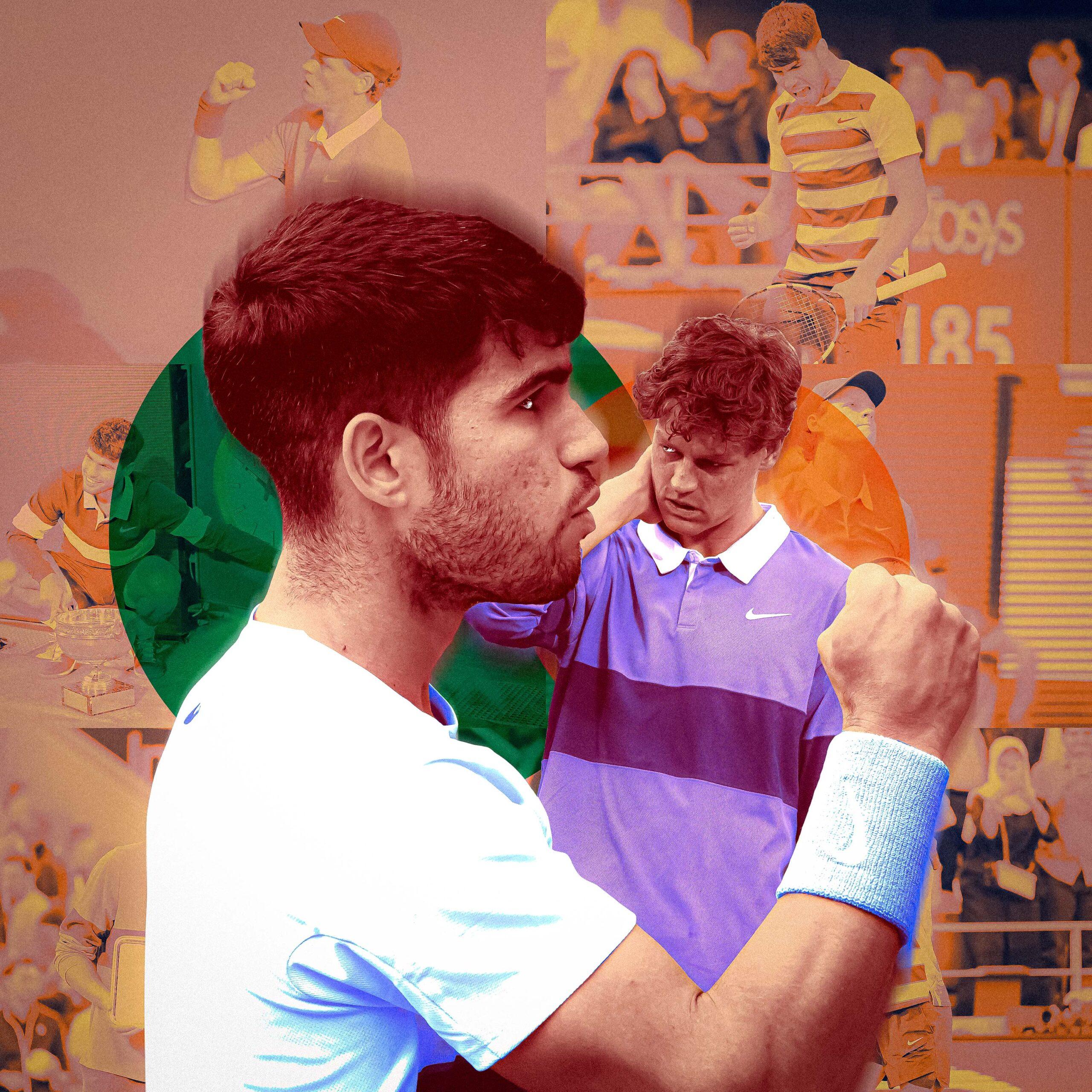
Before Sunday, Carlos Alcaraz had already put together arguably the most impressive early-career résumé in tennis history. He was 4-0 in major finals. He became the youngest man to reach world no. 1 in 2022, when he won the U.S. Open with three consecutive five-set wins. He upset then-four-time defending champion Novak Djokovic at Wimbledon in 2023 with a fifth-set performance in which he levitated above Centre Court. And he did all of this before turning 22.
It’s easy to get hyperbolic about stars that shine this bright so early, but Alcaraz has lived up to the hype that began internationally when he upset Stefanos Tsitsipas in the third round of the 2021 U.S. Open. When you watch Alcaraz, you never discuss what he can’t do. Because there isn’t anything off limits—he’s able to hit any shot from any position on the court. However, there was one thing he hadn’t yet done before Sunday’s French Open final against Jannik Sinner: come back from two sets down in a grand slam match. Pulling off the ultimate comeback against anyone is difficult. Doing it in a major final against someone with the relentless consistency, pace, and depth of Sinner is like trying to climb Mount Everest in high winds with your legs tied together.
Sunday's French Open final was a marathon that doubled as a sprint, as Alcaraz and Sinner tried to hit almost every ball as hard as possible, whether they were standing inside the baseline or sliding into the corners. They battled fatigue, nerves, and the slimmest of margins. Alcaraz saved his best tennis for the 10-point tiebreak at the end of the fifth set and won the match 4-6, 6-7, 6-4, 7-6, 7-6. At 3-5 in the third set, he saved three championship points on his own serve, then broke Sinner’s serve when the Italian had the championship on his racket. Sunday’s win will be a legacy-defining one that we’ll discuss years after Alcaraz calls it a career. His perseverance, creativity, and incredible shotmaking are what make this French Open remontada against Sinner his finest hour. Or, his finest five hours and 29 minutes, to be exact.
The young Spaniard has spent most of his young career as a usurper. As the chosen one from the time he broke out in 2021, he was supposed to be the sole heir to the sport’s longtime Big Three. He combines the passion of his countryman Rafael Nadal with the defensive skills of Djokovic and the artistic shotmaking of Roger Federer. He plays with a huge smile and an unpredictability that electrifies crowds around the world. When Alcaraz first upset Djokovic at Wimbledon in 2023, that was supposed to be the beginning of the Alcaraz era in men’s tennis. But that’s not quite what happened. It didn’t take long before Alcaraz had a proper rival and challenger who wasn’t almost old enough to be his father.
Sinner, a 23-year-old raised on the ski slopes of the Alps before fully embracing tennis, has power and stability from the baseline that has made him a deserving world no. 1. He’s been the most consistently elite player for the past year and a half on tour, a tennis machine who has won 47 straight matches against players not named Alcaraz dating back to last August. In the 2025 French Open, he reached the final without dropping a set or seeming to break a sweat.
But even throughout Sinner’s rise to the top, Alcaraz has maintained the ace in the hole: the head-to-head advantage. In that same stretch since last August, Alcaraz has beaten Sinner all three times they’ve played. He entered Sunday with four consecutive victories against his rival and a 7-4 record overall. His speed mixes with his creative genius to overwhelm Sinner in the highest-leverage points. Sure, the Spaniard might lose a puzzling U.S. Open match to Dutch journeyman Botic van de Zandschulp or an Australian Open quarterfinal to a hobbled Djokovic, but his ability to play his biggest and best tennis in the most important moments is basically unheard of in a sport that causes even the best in the world to struggle under pressure. Alcaraz’s camp has been working with him to play more high-percentage shots and improve his match-to-match consistency by honing his aggression. But taking that too far would dull his shotmaking genius. This is all part of the package. It’s like watching Maximus in the gladiator ring; you’re there to be entertained, and you will never be disappointed watching Alcaraz.
Sinner is the only player on tour who can match and sometimes even better Alcaraz’s movement and power shot for shot. But Alcaraz’s intoxicating athleticism and dazzling shotmaking have bested Sinner before. It’s how he saved match points against Sinner en route to a comeback, five-set victory in the 2022 U.S. Open quarterfinal that finished at 2:50 a.m. in Queens. And how he came back from down 2-1 again to beat Sinner in the French Open semifinal last year. The two best players in the world have plenty of history, but Sunday was their first head-to-head final. The highly anticipated matchup seemed preordained before a single ball was hit in Paris, and it surpassed even our wildest expectations.
On Sunday, Alcaraz rallied from two sets down to win his second consecutive French Open. Once again, he held off the challenge from the man attempting to dethrone him from the top of the men’s tennis pyramid. Alcaraz wasn’t always playing his best throughout Sunday’s five-hour match, but he never quit. He can always rely on his legs for defense. And he has an uncanny ability to save his best tennis for the exact moment when his back is most pressed against the wall.
In theory, you might trust the more reliable Sinner to produce better late-match tennis than Alcaraz, who is prone to more inconsistency. Sinner is a tennis robot programmed with elite forehands and backhands and, most importantly, an improved ability to cover the court and finish with quality volleys at the net. He’s not just a baseline basher anymore but an all-around talent. He’s the kind of player you might back to beat the innovative Alcaraz, who will try drop shots that seem impossible … until they aren’t. You don’t think that the Spaniard can get to that ball on the run … until his passing shot lands on the line and you’ve lost the point. Instead of just defending and locking down, Alcaraz is cranking the pressure dial at the zenith.
Alcaraz and Sinner’s presence at the top of the sport isn’t just the start of the next big rivalry in tennis. The two men have combined for the past six grand slam titles—Sinner has won the past three on hard courts, and Alcaraz won the past three on natural surfaces. It’s also a smothering of the generation that preceded them. Sinner and Alcaraz have blotted out the sun and taken all of the oxygen for themselves.
The players in this previous group—Alexander Zverev, Daniil Medvedev, Casper Ruud, Stefanos Tsitsipas, Dominic Thiem, Andrey Rublev, and others—were told coming up through the ranks that they just had to wait out the Big Three to get their turn at glory. But now that Federer and Nadal are retired and Djokovic has hinted he’s nearing his end, that generation has been passed up entirely. In their focus on the players ahead of them, they failed to realize that players in the rearview mirror were closer than they appeared.
If I were a slightly older professional on the men’s tour watching Alcaraz and Sinner bash balls at each other with remarkable pace for five-plus hours on Sunday, I would contemplate hanging up the racket. It would be disheartening to realize that those two guys are both considerably younger and better than you already. What are you supposed to do now? The door to a breakthrough seems closed while these two guys are at this level.
It’s one thing when there’s one superhuman dynamo at the top of the sport. But now there are unquestionably two. It’s not like Sinner “choked” away Sunday’s final. There’s no question he would want that second serve return back on championship point at 15-40 in the fourth set. He absolutely should have served better to close out the title. But the one major criticism of Sinner’s game was that he didn’t have the stamina to maintain his level in long matches. It’s true that he’s now just 6-10 in five-set matches in his career, but physicality and endurance were not the reasons Sinner lost his fourth-set lead. In fact, Sinner showed incredible fitness and resilience when he broke Alcaraz serving for the match in the fifth set. Sinner again came within two points of winning the Open in the fifth set. Alcaraz just raised his game to another level.
One of the beautiful things about evenly matched rivalries is that they force both parties to continue to raise their levels to match their competitor. Think about the dynastic Warriors vs. the LeBron James–led Cavaliers. The constant back-and-forth record-setting of Peyton Manning and Tom Brady in the AFC. Or how the Bills tried to engineer a defense specifically to slow down Patrick Mahomes (OK, maybe not the best example). Federer, Djokovic, and Nadal would not have become as great as they did if it weren’t for their rivals constantly testing the limits of tennis. Alcaraz did just enough to hold off Sinner this time, on the surface where he has the biggest perceived advantage. As the venue shifts to the London grass or the Queens hard courts for the final two grand slams of the year, the bar has been set. This emerging rivalry is as entertaining and dramatic as any sporting event on the calendar. We were all witnesses as Alcaraz embraced the hunted role and surprised us yet again.

